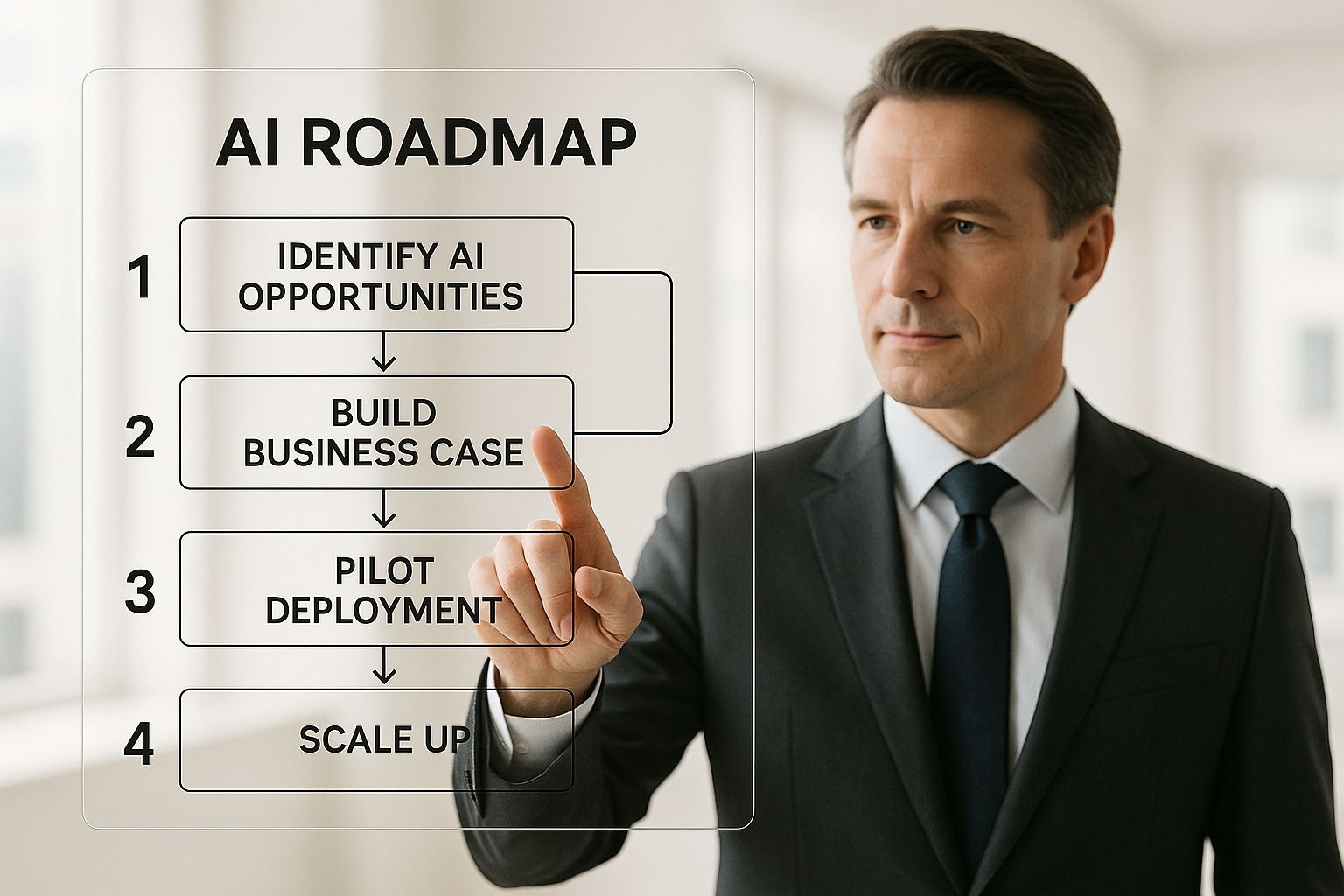Implementing AI in Business: A Practical Guide
Successfully bringing AI into your business is a strategic journey, not a quick fix. It all starts with a clear roadmap—one that helps you find high-impact opportunities, build a solid business case, and run a controlled pilot project before you even think about scaling up. This methodical approach is the secret to making sure your AI initiatives actually deliver value and line up with your company’s core goals.
Your Strategic Roadmap for AI Implementation
Starting an AI project can feel overwhelming, but a structured plan turns a mountain into a series of manageable hills. The real goal here is to move past just tinkering with AI and start embedding intelligent systems into your daily operations to drive real, measurable growth. This takes careful planning, getting everyone on the same page, and a clear-eyed view of both the potential rewards and the work required.
Success isn’t about chasing every shiny new AI tool. It’s about strategically picking and deploying solutions that solve genuine business problems.
The pace of AI adoption is staggering. In 2023, 55% of global organizations were using AI in at least one business function. By 2025, that number is projected to jump to 78%. This isn’t just a slow creep; it’s a massive shift from niche experiments to widespread integration. Generative AI, in particular, has exploded, with 71% of companies expected to be using it in some capacity by 2025. You can dig into the full details in the Stanford HAI 2025 AI Index Report.
The Four Pillars of a Successful AI Rollout
A winning AI implementation is all about a phased approach that keeps risk low and the chances of success high. Each stage builds on the last, creating momentum and proving its worth along the way. Think of it like building a house: you pour the foundation before putting up the walls. Rushing a step only leads to costly fixes down the road.
This process flow gives you a bird’s-eye view of a strategic AI roadmap, showing the key milestones from spotting an opportunity to a full-scale rollout.

As you can see, successful AI integration isn’t a straight line. It’s a cycle of planning, testing, and scaling that ensures each step is solid before you move to the next.
Key Stages of AI Implementation
This table breaks down the core phases of a well-planned AI initiative. Understanding these stages is essential for any leader looking to integrate AI effectively.
| Stage | Primary Goal | Key Activities |
|---|---|---|
| 1. Opportunity Identification | Find high-value use cases. | Analyze workflows, identify bottlenecks, brainstorm data-driven solutions, and prioritize based on impact and feasibility. |
| 2. Business Case Development | Secure buy-in and resources. | Define KPIs, project ROI, detail resource needs (people, tech, data), and present a clear plan to stakeholders. |
| 3. Pilot Project | Prove the concept and validate assumptions. | Develop a minimum viable product (MVP), test in a controlled environment, gather data, and demonstrate tangible results. |
| 4. Scale & Optimize | Integrate the solution across the business. | Plan full deployment, train users, monitor performance, and establish a feedback loop for continuous model improvement. |
Each stage is a building block, creating a solid foundation for the next and ensuring your investment pays off in the long run.
From Idea to Integration: A Step-by-Step View
Let’s unpack these pillars into actionable steps. A firm grasp of this process is crucial for any leader focused on implementing AI in business.
- Find Your AI Opportunities: The first step is always discovery. Look at your current workflows to spot the bottlenecks, the mind-numbing repetitive tasks, or the areas where data-driven predictions could be a game-changer. It’s not about finding a problem for a cool AI tool, but finding the right AI for your most pressing problems.
- Build a Rock-Solid Business Case: Once you’ve pinpointed an opportunity, you need to turn it into a story that executives can get behind. That means defining specific KPIs, projecting a realistic ROI, and outlining exactly what you’ll need in terms of people and budget.
- Launch a Smart Pilot Project: A pilot is non-negotiable. It lets you test your idea in the real world without betting the farm. You can validate your assumptions and show tangible results on a small scale, which builds the confidence and momentum needed for a bigger rollout.
- Scale and Keep Optimizing: After a successful pilot, it’s time to go big. This final stage is about more than just flipping a switch; it involves managing the deployment, training your team, and setting up a continuous feedback loop to monitor performance and fine-tune the AI models over time.
A common mistake is treating AI implementation as just an IT project. It’s a strategic business initiative that demands collaboration across departments, strong leadership, and a company culture that’s ready for change.
Trying to navigate this on your own can be tough. Working with an expert AI solutions partner can provide the guidance you need to connect the technology to your business goals. Kicking things off with a structured session, like our AI Discovery Workshop, is a great way to pinpoint the most valuable opportunities and build a clear, actionable plan from day one.
Finding and Prioritizing High-Impact AI Use Cases

The first step in any successful AI journey isn’t about the tech; it’s about solving the right problem. I’ve seen too many companies get swept up in the latest AI trend, only to end up with a solution looking for a problem. The real wins come from pinpointing core business challenges where AI can deliver clear, measurable value.
Think of it as an internal treasure hunt. Your business processes are the map, and the “X” marks the spot where a bottleneck, a soul-crushing repetitive task, or a data-starved decision is costing you real time and money.
Mapping Your Operational Landscape
You need to get a feel for the ground truth. Start by walking through your key workflows—from the customer support desk and marketing engine to the finance department and warehouse floor. More importantly, talk to the people who live in these processes every single day. They know exactly where the friction is.
Keep an eye out for patterns, especially areas defined by:
- High-Volume, Repetitive Tasks: Things like manual data entry, processing invoices, or triaging support tickets. These are the low-hanging fruit for automation, and freeing your team from this work is an immediate morale and productivity booster.
- Complex Data Analysis: Are your analysts drowning in spreadsheets, trying to spot trends? AI can chew through massive datasets in minutes, uncovering patterns that lead to smarter forecasts and sharper decisions.
- Critical Decision Bottlenecks: Where do things grind to a halt waiting for a human judgment call? AI can act as a co-pilot, serving up data-driven recommendations to speed up everything from credit approvals to inventory replenishment.
A great example is an e-commerce brand using AI to analyze browsing behavior in real-time to personalize product recommendations with Custom Ecommerce Solutions. Or a clinic that integrates predictive diagnostics into its system via healthcare software development to identify at-risk patients far sooner than a manual review ever could.
The goal here isn’t just to automate for automation’s sake. You’re looking for problems where the solution gives you a genuine competitive edge, unlocks a new capability, or creates a customer experience that your competitors can’t match.
A Framework for Prioritizing Opportunities
Once you’ve got a list of potential use cases, you need a way to separate the gold from the glitter. Not all AI projects are created equal, and your resources are finite. A simple scoring framework is the best way to bring objective clarity to what can be a very subjective decision.
I recommend a simple matrix that scores each project on two axes: Business Impact and Technical Feasibility. Those high-impact, high-feasibility ideas? Those are your quick wins. They build momentum and prove the value of AI to the rest of the organization.
Here are the factors I always use to evaluate an idea:
- Projected ROI: What’s the bottom-line impact? You have to define clear metrics. Will it be cost savings from automation? Revenue growth from better personalization? Or maybe productivity gains from faster workflows? A project with a fuzzy, hand-wavy ROI is a major red flag.
- Strategic Alignment: Does this initiative directly support a major business objective? An AI tool that helps you nail a top-level company goal is infinitely more valuable than a cool but isolated experiment.
- Data Availability and Quality: AI runs on data. Full stop. Be brutally honest: do you have enough clean, relevant data to train an effective model? If your data is a mess or stuck in silos, you have to factor in the very real cost and time of getting it ready. This is a critical point we cover in our overview of data and AI services.
- Technical Complexity: Can you build this with your current team and off-the-shelf tools, or does it require a team of PhDs and brand-new research? Be realistic. It’s often smarter to start with a less complex project to build skills and confidence.
By scoring each use case against these criteria, you transform a scattered wish list into a strategic, prioritized roadmap. This disciplined approach ensures you’re not just dabbling with AI but making smart investments that will deliver the greatest return and build a solid foundation for everything that comes next.
Building a Business Case That Wins Over the C-Suite
Let’s be blunt: an AI project without a rock-solid business case is just a science fair project with a bigger budget. To get your idea off the whiteboard and into the real world, you need to build a proposal that speaks the language executives understand—results, costs, and strategic fit. This is where you stop talking about algorithms and start talking about a return on investment.
Getting that green light from leadership comes down to being incredibly clear and specific. Vague promises like “we’ll improve efficiency” are dead on arrival. You need to show them the numbers from day one.
Ditch the Vague Goals for Hard Metrics
Your first job is to pin a number on every objective. This is how you turn a nice-to-have idea into a can’t-ignore business target. The trick is to directly connect your AI solution to a key performance indicator (KPI) the company is already obsessed with.
Think about it this way:
- Don’t say: “Improve customer support.”
- Instead, propose: “We will reduce average customer ticket resolution time by 30% within six months.”
- Don’t say: “Make our marketing better.”
- Instead, propose: “This will increase marketing qualified leads (MQLs) from our content channels by 15% in the next quarter.”
See the difference? That level of specificity makes the potential impact crystal clear and gives everyone a concrete benchmark for success. A well-crafted business case isn’t just a hurdle to clear; it becomes your project’s North Star, often brought to life through powerful business intelligence services that track your progress.
Get Real About the Return on Investment
Once you have your metrics, it’s time to talk money. You need a financial projection grounded in reality, which means taking a hard, honest look at both the costs and the potential returns. One of the quickest ways to lose credibility is to lowball the costs.
Make sure your cost analysis covers all the bases:
- Tech & Infrastructure: This includes everything from licensing for AI platforms and cloud computing bills to data storage.
- People: Are you hiring data scientists and engineers? Or are you bringing in an external partner for AI development services? Factor it in.
- Data Prep: This is the silent killer of many AI project budgets. Cleaning, labeling, and structuring your data for an AI model takes serious effort.
- Upkeep: The work doesn’t stop at launch. You need to budget for monitoring, retraining, and updating the solution over its entire lifecycle.
Don’t just throw out a single ROI number. Show a timeline. Project the returns over one, three, and five years. This demonstrates the long-term value and shows exactly when the initiative pays for itself and starts turning a profit.
On the other side of the ledger, you have to quantify the gains. If you’re automating a tedious manual process, do the math—calculate the hours saved and multiply that by the average employee cost. If your project improves sales forecasting, estimate the revenue bump from having the right products in stock. Hard data makes your ROI projection bulletproof.
Tie it All Back to the Big Picture
Finally, you have to explicitly connect your AI project to the company’s most important strategic goals. Is leadership focused on breaking into new markets, achieving operational excellence, or making customers ridiculously loyal? Frame your project as a tool to get them there faster.
This alignment demonstrates that you’re not just chasing shiny new tech. You’re using it strategically to push the entire business forward. For example, an AI-powered logistics tool isn’t just about “optimizing routes.” It’s about “supporting our company-wide goal of reducing our carbon footprint and operational costs by 10%.”
The great news is you have data on your side. An IBM survey from 2023 found that 64% of businesses saw major productivity gains from AI. More recent 2024 data shows an incredible 83% of organizations hit a positive ROI within just three months. You can find more details on AI’s rapid business impact on Ventionteams.com. Bringing this kind of market validation to the table shows you’re not proposing a risky bet, but a proven strategy for growth.
Moving From a Pilot Project to Full-Scale Deployment

Trying to launch a company-wide AI initiative in one go is a high-stakes gamble that almost never pays off. I’ve seen it time and again. The smart money is on starting small, proving the concept, and then scaling up with confidence. This is exactly what a pilot project is for—it’s your controlled, real-world test to validate the AI and build momentum.
Think of it as the ultimate dress rehearsal. You wouldn’t open a new restaurant without a soft launch, right? The same logic applies here. In fact, as we explored in our AI adoption guide, Gartner points out that only a dismal 53% of AI projects actually make it from prototype to production. Why? Because what works in a sterile lab often breaks in the messy reality of day-to-day operations.
Defining a Meaningful Pilot Scope
The secret to a great pilot is finding the sweet spot. It needs to be significant enough to produce real, eye-opening insights but contained enough to stay nimble and manageable. If it’s too small, stakeholders will shrug. Too ambitious, and the whole thing can collapse under its own weight.
Your mission is to isolate a single process or a very specific group of users. For instance, instead of trying to automate the entire customer support department, just deploy an AI chatbot to handle one common query, like “password reset requests.” This surgical approach lets you measure the impact with incredible precision.
This is where true technical expertise really matters. The nitty-gritty of data prep, model training, and plugging the AI into your existing tech stack demands specialized skills. It’s why many companies find it easier to partner with custom software development experts to make sure the pilot is built on solid ground from day one.
The pilot isn’t just a technical test; it’s a political one. Its primary purpose is to generate undeniable proof—hard data and enthusiastic user testimonials—that builds the case for a wider investment.
From Successful Pilot to Phased Deployment
So, your pilot smashed its KPIs. The temptation is to hit the big red button and launch it for everyone. Don’t do it. A phased deployment is the only way to go, giving you a chance to manage the organizational shift and tweak the solution based on live feedback.
Start by expanding the user base bit by bit. Roll the AI tool out to just one department or a single region first. This turns those initial users into internal champions and gives your technical team a steady stream of feedback to keep refining the models.
Now is also the time to make a crucial long-term decision: do you build an in-house AI team from the ground up, or do you stick with an expert partner? Both paths have very different implications for your budget, timeline, and level of control.
AI Implementation Approaches Compared
Deciding whether to build your own team or hire outside help is a major fork in the road. Here’s a quick breakdown of what to consider.
| Factor | In-House Team | External Partner |
|---|---|---|
| Speed to Market | Slower, due to hiring and ramp-up time. | Faster, with immediate access to specialized expertise. |
| Upfront Cost | High, including salaries, benefits, and training. | Lower initial investment, often project-based. |
| Long-Term Control | Full control over IP and project direction. | Varies by contract; requires clear agreements. |
| Access to Talent | Challenging; competitive market for AI specialists. | Access to a broad pool of vetted, experienced engineers. |
| Scalability | Limited by hiring capacity. | Highly flexible; can scale teams up or down as needed. |
Ultimately, there’s no single right answer. The best path depends on your company’s resources, strategic goals, and how quickly you need to move. For many businesses, the immediate expertise and flexibility of a partner is the most efficient way forward, especially when you can structure the engagement using proven models for distributed agile teams.
This transition from a small-scale pilot to a full deployment is where an exciting experiment becomes a genuine, value-driving business tool. By managing this stage carefully, you sidestep common pitfalls, build the internal support you need, and ensure your AI investment pays dividends for years to come.
Taking AI Mainstream: How to Scale Your Success and Build a Smart Culture
Getting a single AI project off the ground is a fantastic start, but it’s just that—a start. The real, game-changing advantage comes when you build an organization-wide capability for AI, turning one-off wins into a continuous engine for innovation.
This final stage is less about the tech and more about your people and processes. It’s about making sure your initial successes create a ripple effect, compounding value across the entire business.
Scaling isn’t just deploying more algorithms; it’s about fundamentally changing how your teams think and work. It requires solid governance, a real commitment to upskilling your people, and creating a feedback loop that makes your AI solutions smarter with every use. This is where experience from structured approaches, like those used in SaaS Consulting, can be incredibly helpful for managing this kind of technology-driven change.
The Mission Control for AI: Your Center of Excellence
As AI projects pop up across different departments, you’ll quickly run into a common problem: disconnected silos and teams reinventing the wheel. The solution is an AI Center of Excellence (CoE). Think of it as the central nervous system for everything AI in your company.
A CoE is tasked with setting standards, sharing what works (and what doesn’t), and making sure every AI initiative is pulling in the same direction—towards your core business goals.
But this isn’t just an IT-led group. A truly effective CoE is a cross-functional team that brings together:
- The Tech Experts: Your data scientists, ML engineers, and architects who have the deep technical know-how.
- The Business Minds: Leaders who live and breathe the company’s strategic goals and can spot the most valuable opportunities for AI.
- The Guardians: Ethicists and governance specialists who ensure every AI application is responsible, fair, and compliant.
The CoE’s job isn’t to hoard knowledge, but to spread it. They should be your AI evangelists, giving everyone else in the organization the tools and guidance to succeed.
By centralizing the rules of the road, the CoE prevents a “wild west” of uncoordinated experiments. It ensures that every project, whether it’s for marketing or your supply chain, is built on a solid and ethical foundation. This structured oversight is absolutely essential for effectively scaling AI for your business.
It’s a People Thing: Fostering a Data-Fluent Culture
You can have the best technology in the world, but it won’t get you far without the right people and culture. Scaling AI means making a serious investment in your workforce and creating an environment where data is everyone’s second language.
This goes beyond just teaching employees how to use a new AI tool. They need to learn how to collaborate with it. That means understanding, on a practical level, how an AI system comes up with its recommendations, knowing its limits, and seeing where their own human expertise can fill the gaps. That’s where the real magic happens—in that partnership between human and machine.
Just look at the numbers. The wearable AI market is projected to hit $180 billion by 2025, and AI could add a staggering $3.78 trillion to the manufacturing sector by 2035. These figures aren’t just about algorithms; they represent entire industries retooling their workforces to work alongside AI. You can dig into more of these booming AI market trends on Synthesia.io to see just how big this shift is.
Never “Set and Forget”: The Continuous Improvement Loop
An AI model isn’t a piece of software you install once and walk away from. Its performance will inevitably degrade as the world changes—customer behavior shifts, market conditions fluctuate, and new data patterns emerge. This is a well-known phenomenon called model drift.
To get long-term value, you need a robust feedback loop to keep your models sharp.
This boils down to a few core practices:
- Keep an Eye on Performance: Are the models still hitting the KPIs you defined way back in the business case? You need to be tracking this constantly.
- Listen to Your Users: Give your employees a simple, direct way to flag when an AI suggestion feels wrong or a system is acting weird. This on-the-ground human feedback is gold for spotting subtle problems.
- Schedule a Refresh: Don’t wait for things to break. Plan for regular retraining cycles to update your models with fresh data, keeping them relevant and accurate.
This cycle of improvement ensures your AI investment doesn’t just pay off once. It becomes a living, evolving asset that gets smarter and more valuable over time, turning your company into a truly intelligent enterprise.
Common Questions We Hear About AI Implementation
When you start diving into AI, a lot of questions pop up. It’s only natural. Drawing from the real-world experience our expert team has gained from countless projects, we’ve put together some straightforward answers to the questions we hear most often from business leaders.
What’s the Single Biggest Hurdle in AI Implementation?
You might think it’s the technology, but it’s almost always about the data and the people. I can’t tell you how many promising projects we’ve seen stall because of poor data quality, siloed information, or just a lack of the clean, structured data you need to train a decent AI model. A solid data strategy isn’t just a nice-to-have; it’s the foundation of everything.
Then there’s the human element. Resistance to change is a powerful force, and if your team doesn’t understand why you’re bringing in AI, they’ll see it as a threat. Getting this right takes strong leadership, clear communication about the benefits for them (not just the company), and a real commitment to upskilling your workforce.
How Do You Actually Measure the ROI of an AI Project?
Measuring the return on an AI investment has to start long before you write a single line of code. You need to define crystal-clear, quantifiable metrics from day one. Vague goals like “improve efficiency” just won’t fly.
We find it helps to bucket these metrics into three main categories:
- Cost Reduction: This is the most straightforward. Think about savings from automating repetitive tasks or reducing operational costs.
- Revenue Generation: Are you seeing more sales from hyper-personalized recommendations? Better lead conversion rates? Did you launch a new AI-powered service? That all goes here.
- Productivity Gains: This is about getting more done in less time. Faster decision-making, quicker product launches, or higher output per employee are all great indicators.
The key is to establish a firm baseline before you start. For example, if you’re deploying an AI chatbot for customer service, you need to know exactly how many support tickets your human agents handle today. After launch, you can track the reduction in those tickets and calculate the direct cost savings. That gives you a hard number to show the value.
Should We Build a Custom AI Solution or Just Buy One?
Ah, the classic “build vs. buy” debate. The right answer really depends on your specific needs, your budget, and how quickly you need to move.
Buying an off-the-shelf tool—like a CRM with built-in AI features—is often the fastest and cheapest way to get going for common problems. You don’t need a massive in-house technical team to get started.
On the other hand, building a custom solution with an AI solutions partner is the way to go when you’re solving a problem unique to your business. If you have proprietary data that gives you a competitive edge or need to integrate deeply with legacy systems, a custom build is almost always worth it. Sometimes, the best path is a hybrid one: taking a pre-built platform and customizing it to fit your exact needs.
Ready to turn your AI vision into a reality? At Bridge Global, we specialize in creating intelligent software solutions that drive real business outcomes. Whether you need end-to-end AI development services or expert guidance to refine your strategy, our team is here to help you build, deploy, and scale with confidence.



